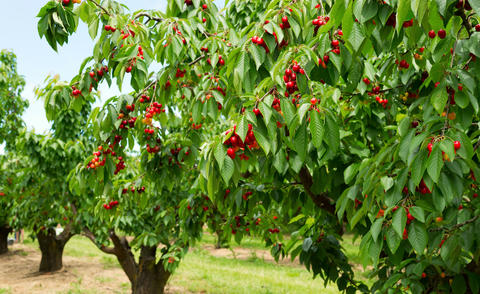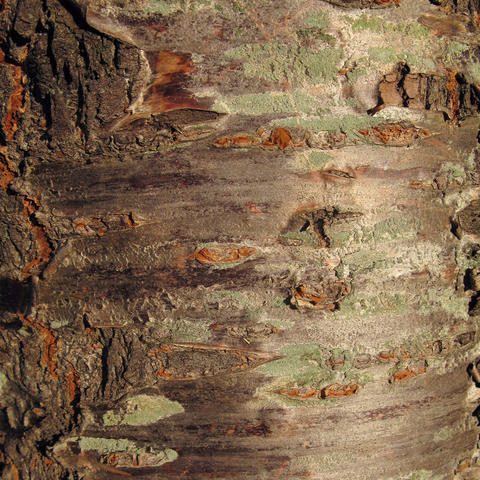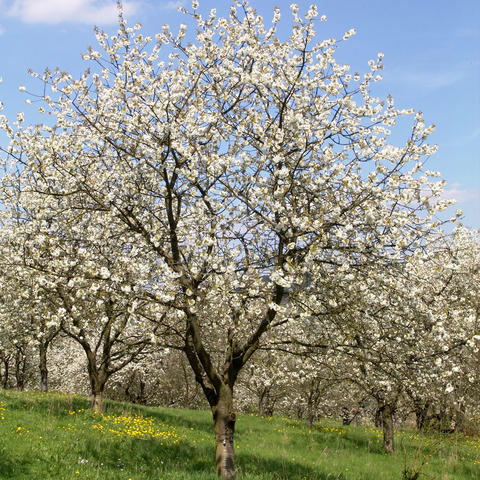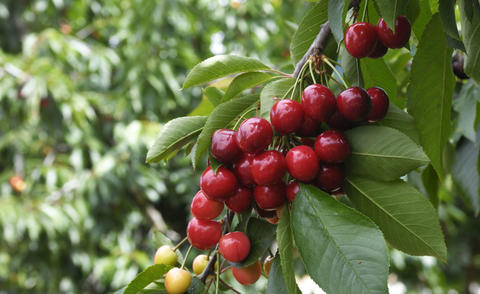Cherry tree
Be it sweet cherry or sour cherry: There should be a cherry tree in every garden. With our tips on planting, care and pruning, it will thrive in your garden too.
Sweet or sour – this is the first question that crops up when it comes to cherry trees. Once this is clear, can get to know about its origin. Sweet cherry and sour cherries belong to the genus Prunus, which in turn belongs to the rose family (Rosaceae). Both cherry trees are closely related to the plums. All three are stone fruits, which also includes apricot, peach and nectarine.
The sweet cherry tree found in the wild is called the wild cherry (Prunus avium). The origin of the sour cherry (Prunus cerasus) is not so clear: Possibly, it is a hybrid between wild cherry and steppe cherry (Prunus fruticosa), in any case, geneticists have found out that it contains double chromosome set of the sweet cherry. The common “mother” of both cherry trees is therefore — partially or fully — the wild cherry. It is native to Europe and Central Asia, however, it’s been cultivated in North Africa, America and India since a long time. In the wild, it prefers to grow along the forest edge on sunny or shaded locations or in thickets; they can even be found at a height of 6561.5 feet in the mountains.

Sweet cherry trees were first cultivated in Europe from 63 BC. General Licinius Lucullus first brought it to Rome from the Turkish city, now known as Giresun. In 50 AD, its cultivation started in Germania, Gaul and Britain. In Germany, Baden-Württemberg is at the forefront of sweet cherry blossom cultivation, followed by Franconian Switzerland, Brandenburg and Old Saxony. Cultivation of sweet cherries in Switzerland dates back to 600 years. In the Zug region, several customs and traditions of the Canton are centered around the cherry tree: The Chriesisturm (Cherry rush) probably dates back to the 18th century, which kicked off the cherry harvest season: Once the cherries were declared ripened and the church bells rung and the contest began: Armed with ladders and baskets, the people of Zug ran through the whole city into the common land. Cherry trees planted there, belonged to common people.
Sour cherry cultivation has lagged behind the sweet cherry cultivation in the last few decades. Now the fruit is gaining popularity again: Sour cherries are healthy because of its acid content and other valuable constituents; it has good antioxidative properties thanks to phenols and anthocyanins. The latter are known for inflammation-inhibiting and, not to forget, the tumor-growth suppressing effect. Last, but not the least, a sour cherry tree scores points because it is undemanding when it comes to care. It’s delicate growth makes the cherry tree ideal for small gardens.
Additional information regarding sweet and sour cherries can also be found in the following articles:
In nature, sweet cherry trees typically have a large crowns and thick trunks, sour cherry trees on the other hand, are stocky trees with lightly hanging branches. Depending on the understock as well as the breeding, you can find shrub-shaped, trellis, columnar trees as well as trees with varying crown heights.
Sour cherries come in two varieties, amarelle (Prunus cerasus subsp. cerasus) and dark morello (Prunus cerasus subsp. acida). Amarelles are also commonly known as sour cherries. They have a light-colored flesh and almost colorless juice. The dark morello cherries are dark red in color. Amarelles are further divided into the variety “austera", a cross between sweet and sour cherries known as duke cherries or morello, as well as the "marasca" variety, the maraschino cherry.

The tree bark is strikingly reddish-brown or even silvery-brown in color, lenticels are also clearly visible on it. In older cherry trees the bark coils horizontally around the trunk, similar to . Similar to birch trees, there is no bark, at most on very old cherry trees, bark is found at the bottom of the trunk. The cherry tree wood is red in color and is quite popular in the furniture industry as veneer or solid wood.

The roots of the cherry tree are cordate. Surface roots often develop basal shoots, if they are damaged due to hoeing or lawn mowing.
The leaves of the cherry tree, which are arranged helically around the shoot, have the shape of an ellipse and end in a clear tip. The leaf margin is serrated, parallel nerves are clearly visible on the lamina. Typically seen in all Prunus varieties are two nectar glands on the leafstalks, which are also used for ascertaining the variety. The leaves of the sour cherry feel firm to touch, they are usually smaller in comparison.
The single flowers, which appear anywhere from the early April to early May — depending on the variety — are grouped in umbels. They have five petals and as many sepals. The stamens are numerous and located at the center of the flower. Wild cherries and sweet cherries bloom before the leaves sprout and two weeks earlier than the sour cherry.

Fruits develop from the blooms during the summer, which are less acidic in sweet cherries as compared to sour cherries. The fruits of the sweet cherry also have a softer skin and more tender pulp. In the cultivated varieties, the sweet cherries are divided into two subspecies: the heart cherries and the bigarreau cherries. The first has a soft, dark fruit pulp and ripens relatively early. They are usually ripe by early July. These cherries seldom split, even in case of precipitation or heavy rainfall. That means even heavy rain showers don't impact them so fast. However, storage and above all, transport, are problematic: Since they have a soft fruit pulp, they get bruised easily and start to rot. The bigarreau cherries are also known as knubber or knupper cherries in Germany. They have a much firmer pulp, which is why they don't bruise so easily during transport. They typically ripen only after the first week of July. As these cherries are very firm, they split up very easily when it rains. The peel of the biggareau cherries cannot withstand the increase in pressure resulting from the osmosis of the penetrating water.
In botanical terms, cherries are stone fruits: The innermost layer of the pericarp (endocarp) forms a hard covering that encloses the seed. The middle layer of the pericarp (mesocarp) forms the fruit pulp. The leathery skin, which covers the fruit, is the exocarp. Two to six fruits hang in the umbels. Usually sweet cherries ripen faster than sour cherries.

To grow tasty cherries, the tree needs to be planted in a location with full sun. Well supplied with nutrients, the soil should run deep and be rich in humus, a bit of clay can be present. In principle, sour cherries are less demanding. The sweet cherries cannot survive in cold, dense and waterlogged soil. Soils with low-lime content and summer-dry locations work best. An unsuitable location could lead to gummosis, which blocks the circulation pathways in the wood and even kills the most sturdiest of branches. Even the winter cold can lead to frost splits. However, flowering requires a bit of cold stimulus: Sweet cherries require up to 1600 cold hours in winter, or else there might be a loss in yield.
In case of the cherry tree, as with other fruit trees, growth and yield are impaired if they are repeatedly planted in the same place. This phenomena is called “soil fatigue”. If you plan to have a cherry tree at a location where previously a cherry tree was planted, then the soil needs to be replaced to a large extent. Planting of nematode-combatants such as marigolds or pot marigolds, kill harmful organisms like lesion nematodes.

Depending on the growth and breeding, the space requirement of a cherry tree can differ; it can range anywhere from 11.95 to 59.79 square yards. Columnar cherry trees are particularly narrow, they also grow in a large tub with a volume of at least 30 liters of soil.
A large planting hole that is twice the volume of the root ball is always useful. When you replant, the cherry tree should not be placed lower than it was before in the container or in the field. In the case of bare-root cherry trees, the uppermost roots should only be slightly covered with soil, and under no circumstances should they be set too deep.
All trees should be fixed with a post so that fine roots do not tear off. Especially with small or columnar shaped trees, it makes sense to keep the post for life in order to stabilize the trunk under the weight of the fruit. The grafting site must be above the ground!

In the past, cherry trees were mostly grown as medium and high trunks with hollow or round crowns on a vigorous base. Nowadays, low stems or spindles are preferred on weaker roots. The focus should be on a continuous central trunk from which the lateral branches and fruit branches fork out. These in turn are placed horizontally.
For the cherry tree, nutrients must be added to the soil every year in spring. When the climate changes, young trees in particular should be supplied with water at the time of fruit set and later regularly so that the cherries do not split.
A pollinator variety is often necessary for abundant fruit growth, especially with sweet cherries, because they are non-self-pollinating. When choosing, one should make sure that the flowering period overlaps. Even if a cherry variety is described as self-pollinating, a second tree increases the flowering rate and the yield. Sour cherries can usually self-pollinate.
The ripening time of the cherries extends over two months, whereby the sweet cherry varieties ripen in different calendar weeks. Sour cherries are smaller, softer, more acidic and more juicy than sweet cherries. A large part of the sour cherries is processed into nectar, jam, fine brandies or liqueurs. You can also make cherry preserves. Only a small proportion of the fruits that are sensitive to transport and do not have a long shelf life, reach the market. Sweet cherries are usually eaten fresh. They are more durable than their sour sisters. All cherries are also distilled into schnapps.
Cherries must be harvested with a bit of caution: Cherries must be picked with a stalk, then the fruit can be kept longer, the tree is also spared, the next year's fruit buds, which are placed directly next to the stalk, remain undisturbed. To do this, you twist the fruit from the stem. Sour cherries should be harvested with shears. The fruits detach from the stem with some difficulty. This method can be used to avoid a tear on the pedicle base and in turn avoid the infection ofmonilia tip drought.

In the meantime, there is growing consensus that the regional varieties of cherry trees should be promoted, as they are better adapted to late frost or summer drought. At the beginning of the 20th century, for example, Christian Truchsess von Wetzhausen described more than 200 cherry varieties, many of which have disappeared, but which are now being intensively researched again. Hopes are high to find genetic material that can be of great importance with regard to global warming. Horticulture institutes of the country usually give the recommendations. One of the most popular sour cherry varieties is the “Jachim” variety, it has a columnar growth and is also suitable as a container plant. “Spinel” is relatively large and tastes great fresh too.

Especially in the case of the vigorously growing sweet cherries, low growth inducing rootstocks such as those of thethe GiSelA-Clone 5 and 3, PiKU-Klone, MaxMa14, are used today, and the bird cherry (Prunus avium) is used for high stems. For the naturally slow-growing sour cherries, rootstocks have a limited role to play. Both types of cherries, like other fruit trees grafting: One eye is placed at the soil level. Grafting is also commonly done for tall trees.
Unfortunately, cherry trees are susceptible to diseases and pests. The sweet cherries are devoured by cherry fruit flies, maggoty fruits are a result of egg deposition. Early varieties that ripen in the third or fourth week of the cherry season usually remain maggot-free. Later varieties are best covered with a small-mesh net.
However, birds prefer to eat early varieties, and bird nets help here. However, these bird-nets need to be regularly checked to see if any bird does not accidentally gets stuck in it and perishes.

The sour cherries are also attacked by monilia fruit flies. The fungus invades the cherry blossoms and kills the entire branch. Rainy weather during the flowering period act as favorable conditions for infections. The shot hole disease which can be identified by round brown leaf spots, and the cherry leaf spot disease that affects the leaves of all cherries.
All cherry trees are susceptible togummosis, which could be trigged by location factors such as waterlogging. The cherry vinegar fly is also an insect pest that causes problems for both cherries. A protective net will help here as well.

